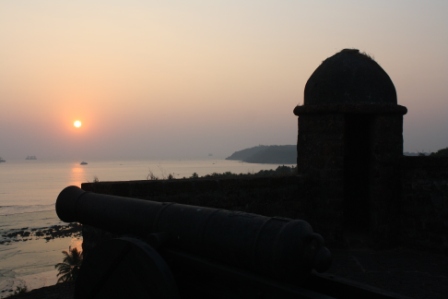
I discovered the charming beauty of Panjim, the capital of Goa, on a New Year’s Eve when I tried to escape the crowds thronging the myriad beaches. Before this, I only used to go to Panjim to catch a bus or rent a scooter to rush to the soft sands of the Arambol or Palolem beaches. Contrary to the opinion of many beach lovers, Panjim (also known as Panaji) is a nice destination where you can spend two or three days without your swimming costume and sunscreen. If you need a break from the beaches in Goa, drive down to Panjim!
Discovering Panjim in Goa
The metropolitan area has a population of 114,000, and the old Latin quarters looks like a Portuguese village with small roads, wineries and minuscule pastry shops where you can taste a slice of ‘bebinka’, a famous Goan dessert made by layers of fruit gelatin.
The Old Latin Quarter
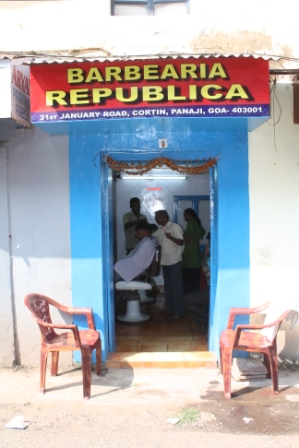
The quarters of Fontainhas, Sao Tome and Altinho, near the Mandovi River, are ideal for leisurely walks. On a stroll you can observe old people speaking in Portuguese or sitting in the shadow of gulmohar trees or bougainvillea. In this area, there are several heritage hotels and restaurants, like the Hospidaria Venite, my favorite place with its small tables on the balconies. The quarter, usually calm and silent, becomes alive during the Carnival in February. In November 2013, Panjim hosted the famous International Film Festival and became the venue of celebrities and fashion.
Our Lady of the Immaculate Conception Church
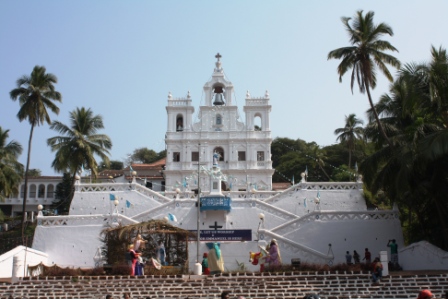
The Praça da Igreja (Church Square) is the heart of the city and starting point for the walking tour. The baroque Our Lady of the Immaculate Conception Church, with its symmetrical flight of steps, is impressive for its monumental dimension. It was built in 1541 on the top of a hill by the Dominicans, but originally it was only a small chapel. The ruins of the old building are still visible from the Parish’s house. At that time, Panjim was only a fishermen’s village on the estuary of the river Mandovi. The ‘entrance door’ to Velha Goa (Old Goa), the so called “Rome of the Tropics”, capital of the Portugal’s colonial empire in Asia and Africa, is situated at a distance of around 10 kilometers. According to the tradition, on this hill (where there probably also was a Hindu temple) the traders from Lisbon used to stop here for thanking God for their safe journey to the Indian coast.
Traces of the Saint Inquisition
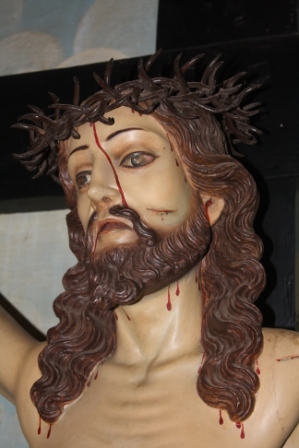
Unfortunately the Portuguese, who left the colony only in 1961 after the Indian military intervention, have not left behind a good reputation. Inside the chapel of Saint Sebastian, in a picturesque corner of the old Latin Quarter, you can see a big wooden crucifix originally situated in the Office of the Inquisition in the former sultan’s palace in old Goa. Curiously, the Christ has open eyes and – according to the traditions – this sculpture was used by the Jesuits priest to punish and convert the Hindu and Muslim residents by force.
Other evidences of this dark period of Christianity are in the Goa State Museum, a good place to spend one hour and to learn something about the history of this land before colonization.
Reis Magos Fort, the ‘sentinel’ of Mondovi River
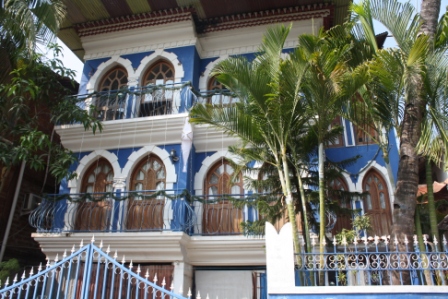
The estuary of the Mandovi River, where today we find floating casinos, was strategically important for the security of Velha Goa. The fort of Reis Magos (Three Kings), in the village of Verem, where there is also an old church with the same name, was the ‘sentinel’ protecting the capital from invaders. It began as an Adil Shahi armed outpost in 1493 and was conquered by the Portuguese in 1541.
The fort was renovated with great attention to the details (included the cannons) and it opened last year as a cultural center. The panoramic view from the rampart is extraordinary and you can imagine the Portoguese galleons of Vasco De Gama arriving on the shores of the ‘new world’.








